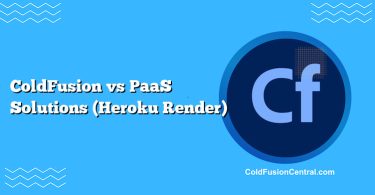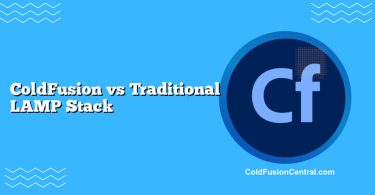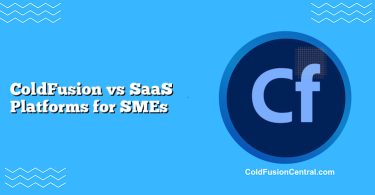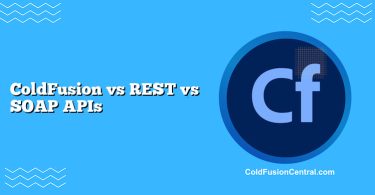Definitions
-
ColdFusion (CFML/CF): A server-side web application platform built on the JVM that uses the CFML language. There are two primary engines: commercial Adobe ColdFusion and the open-source Lucee. It emphasizes rapid application development (RAD) with tag-based syntax, built-in services (PDF, email, scheduling), and straightforward database access.
-
Django: A high-level, open-source Python web framework that follows the Model-Template-View (MTV) pattern. It provides batteries-included features such as an ORM, authentication, admin interface, security protections, and flexible routing, optimized for building secure, maintainable web apps and APIs.
Overview
What is ColdFusion?
ColdFusion is both a platform and a language ecosystem. Developers write in CFML (a blend of tag-based and script syntax), which runs on a Java application server. Adobe ColdFusion offers enterprise features, performance tuning, and commercial support. Lucee is a popular open-source CFML engine that aims for compatibility while emphasizing speed and community-driven development. ColdFusion excels at rapid application development, templating, and tasks like PDF generation, reporting, and server-side integration with mail, scheduling, and caching.
What is Django?
Django is a Python web framework built for speed, security, and scalability. It comes with a powerful ORM, authentication, admin site, form handling, and middleware. Django supports both WSGI and ASGI (for async views, WebSockets via channels). It integrates naturally with the Python ecosystem (NumPy, Pandas, Celery, FastAPI co-existence) and is widely used for content sites, REST APIs, dashboards, and data-heavy applications.
Key Features
ColdFusion Key Features
- CFML tag and script syntax for rapid templating and business logic
- Built-in services: CFDocument (PDF), CFChart, CFMail, task scheduler, image manipulation
- Easy database access via CFQuery, ORM (Hibernate-based in Adobe CF), datasource management
- Session management, caching, and simple configuration
- Enterprise features (Adobe CF): API Manager, performance monitoring, security hardening profiles
- Deploys on JVM; integrates with Java libraries and existing Java infrastructure
Django Key Features
- Python-based MTV architecture; clean URL routing and template engine
- Robust ORM with migrations; supports multiple databases
- Authentication, permissions, and built-in admin interface
- Security protections by default: CSRF, XSS, SQL injection mitigation, clickjacking
- First-class async support via ASGI; works with Gunicorn/Uvicorn/Nginx
- Pluggable ecosystem: Django REST Framework, Celery, Channels, Allauth, Wagtail/CMSs
Performance
-
ColdFusion:
- Runs on the JVM, benefiting from mature JIT compilation and garbage collection.
- Adobe CF adds performance features such as query caching and tuning; Lucee is known for its lightweight speed.
- CFML’s tag abstraction can be very fast for I/O-bound tasks (file, email, PDF), but CPU-bound workloads may require careful tuning.
- Performance at extreme concurrency often depends on JVM thread tuning, datasource pools, and external caching.
-
Django:
- Python performance is competitive for web workloads; with ASGI, Django can handle async I/O efficiently.
- Use Gunicorn/Uvicorn behind Nginx, with Redis or Memcached for cache/session; Celery for background tasks.
- ORM can be fast when query patterns and indexes are optimized; async views shine for high-latency I/O (APIs, microservices).
- For raw throughput, scaling horizontally with multiple workers/replicas is standard.
Practical note: Both platforms usually scale via horizontal replication, caching layers, and database optimization. For micro-optimizations, Django often benefits from Python’s rich profiling ecosystem; ColdFusion benefits from JVM profilers and Adobe PMT (Performance Monitoring Toolset).
Scalability and Architecture
-
Horizontal scaling:
- ColdFusion: Multiple CF instances behind a load balancer; sticky sessions or external session stores; J2EE session replication possible. Lucee supports clustering patterns; Adobe CF has built-in enterprise clustering features.
- Django: Multiple worker processes/containers behind Nginx/HAProxy; sessions via cache/DB/Redis; database read replicas; autoscaling in Kubernetes or cloud PaaS.
-
Architectural styles:
- ColdFusion: Suited for monoliths and service-style endpoints; can call Java classes directly. Many legacy enterprise systems integrate CFML as a web front-end.
- Django: Works well as a monolith or part of microservices; pairs with Django REST Framework for APIs; integrates with message brokers (RabbitMQ, Redis) and data pipelines.
-
Caching strategies:
- ColdFusion: In-memory caches, query caching, integrated caching engines; can leverage external caches.
- Django: Low-level cache API, per-view caching, template fragment caching; Redis/Memcached are common.
Security
-
ColdFusion:
- Security hardening, secure profile options, OWASP-oriented guidance.
- Built-in functions help sanitize inputs; however, historical vulnerabilities emphasize the need for timely patching and secure configuration.
- Adobe releases hotfixes; Lucee community responds quickly to issues. Implement WAF and least-privilege datasource access.
-
Django:
- Defaults to secure practices: CSRF tokens, auto-escaping templates, prepared statements in ORM.
- Security releases are frequent and well-communicated; settings enforce HTTPS, HSTS, and secure cookies easily.
- Widely vetted by the Python community; security middleware is standard.
Bottom line: Both can be secure, but Django’s secure-by-default posture plus broad security tooling is a strong differentiator. ColdFusion demands strict patch management, especially for Adobe CF.
Development Experience and Productivity
-
ColdFusion:
- Very fast to prototype; CFML tags like cfquery, cfoutput make CRUD pages quickly.
- Strong for teams familiar with CFML or migrating from legacy CF apps.
- Adobe CF provides tooling (PMT, API Manager); Lucee has a lightweight dev experience.
- IDE support: VS Code extensions, FusionReactor, and legacy CFBuilder.
-
Django:
- Clean, Pythonic code; built-in admin accelerates internal tools and CRUD.
- Mature ecosystem: linters, formatters (Black, Ruff), pytest, type hints.
- Dev server, migrations, fixtures make data modeling and iteration smooth.
- Django REST Framework accelerates API development.
Syntax/style differences (high level):
- CFML: Tag-based (e.g.,
, ), or script-style; intermixes HTML and server tags easily. - Django: Python code for models/views/serializers; Jinja-like templates; clear separation of concerns encourages maintainability.
Deployment and DevOps
-
ColdFusion:
- Runs on JVM; deployment as WAR/EAR or standalone servers; Windows and Linux friendly.
- Integrates with IIS/Apache or runs embedded; monitoring via JMX/PMT; CI/CD with traditional artifact pipelines.
- Containerization is feasible (Docker images for Lucee and Adobe CF exist) but less standardized than Python stacks.
-
Django:
- Common stack: Nginx -> Gunicorn/Uvicorn -> Django app; packaged with Docker; deployed to Kubernetes, ECS, Heroku-like PaaS, or serverless (via adapters).
- Mature CI/CD practices with pip/poetry, GitHub Actions, and cloud-native observability (Prometheus, OpenTelemetry).
Cost and Licensing
-
ColdFusion:
- Adobe ColdFusion is commercial with per-core or per-server licenses; costs can be significant for large deployments.
- Lucee is open-source and free, reducing TCO; commercial support available via vendors.
-
Django:
- Open-source under BSD license; no framework licensing costs.
- Costs primarily come from hosting, developer time, and optional third-party services.
If budget sensitivity is high and commercial support is not required, Django and/or Lucee are attractive. If you want vendor support with enterprise SLAs, Adobe ColdFusion provides that—but at a price.
Community and Ecosystem
-
ColdFusion:
- Smaller, dedicated community; many long-lived enterprise apps; active Lucee community; third-party tools exist but fewer choices than Python.
- Hiring CFML developers can be challenging compared to Python.
-
Django:
- Large global community; abundant tutorials, packages, and Q&A; fast-moving ecosystem.
- Hiring Python/Django engineers is generally easier; strong talent pipeline.
Real-World Use Cases
When to Prefer ColdFusion
- Migrating or extending an existing CFML codebase where maintaining continuity and leveraging CF-specific features (CFDocument for PDFs, built-in scheduler) are priorities.
- Rapidly building form-heavy internal applications with quick database interactions and server-side rendering.
- Enterprises with established JVM operations looking to integrate CFML with Java libraries and existing infrastructure.
- Organizations needing Adobe’s enterprise support and monitoring tools.
Example scenario: A financial operations team needs a quick internal portal to upload CSV files, generate standardized PDF reports, email summaries, and schedule nightly jobs. ColdFusion’s built-in tags and PDF service get you to a working solution fast with minimal boilerplate.
When to Prefer Django
- Building scalable REST APIs, content-heavy sites, or data-driven dashboards that benefit from Python’s packages (e.g., Pandas, scikit-learn).
- Projects where security best practices, code maintainability, and testability are paramount.
- Teams already proficient in Python or needing to hire from a large talent pool.
- Cloud-native deployments using containers, microservices, and async I/O.
Example scenario: A SaaS product with a public API, multilingual content management, complex permissions, and integrations with machine learning models. Django + DRF + Celery provides a cohesive stack with excellent observability and performance at scale.
Side-by-Side Comparison Table
| Dimension | ColdFusion (Adobe CF / Lucee) | Django (Python) |
|---|---|---|
| Core Language | CFML on JVM | Python |
| License/Cost | Adobe CF: commercial; Lucee: open-source | Open-source (BSD), no license fees |
| Performance | Strong on JVM; good for I/O; tuning needed for high load | Competitive with proper workers/caching; async I/O via ASGI |
| Scalability | Clustered CF instances; JVM tuning; external caches | Horizontal scaling via workers/containers; Redis/Memcached |
| Security | Secure when patched/hardened; historical vulns noted | Secure-by-default; robust middleware and frequent patches |
| Dev Speed | Very fast RAD with tags, built-in services | Fast with admin, ORM, DRF; strong tooling and testing |
| Ecosystem | Smaller community; Java interop | Large ecosystem; abundant packages and libraries |
| Use Cases | Legacy enterprise apps, reports, PDFs, internal tools | Content sites, REST APIs, SaaS, data-heavy and ML-adjacent |
| Deployment | JVM servers; IIS/Apache; Docker images exist | Nginx + Gunicorn/Uvicorn; containers/Kubernetes |
| Pros | RAD, built-in utilities, JVM integration | Security, ecosystem, hiring pool, maintainability |
| Cons | Adobe licensing cost; smaller talent pool | Requires ecosystem choices; Python speed for CPU-bound |
Pros and Cons
ColdFusion Pros
- Extremely fast RAD for server-rendered apps, forms, and reports
- Powerful built-in services: PDF, email, scheduling, image processing
- JVM-based; integrates with Java libraries and tooling
- Lucee offers a free, open-source CFML engine
- Adobe CF adds enterprise-grade monitoring and support
ColdFusion Cons
- Adobe CF licensing can be expensive at scale
- Smaller developer community; harder hiring pipeline
- Historical security issues if not patched/hardened
- Less standardization around modern cloud-native practices
Django Pros
- Security-first defaults and frequent updates
- Vast Python ecosystem and strong community support
- Excellent admin, ORM, and batteries-included philosophy
- Easy horizontal scaling; great for APIs and async I/O
- Strong testing culture and tooling
Django Cons
- Requires selecting components (e.g., Celery, DRF), which can add decisions
- Python’s single-thread performance can limit CPU-bound tasks (use workers or offload)
- Admin is great for CRUD but may require customization for complex workflows
Decision Factors / Which One Should You Choose?
Choose ColdFusion if:
- You have an existing CFML codebase or CF expertise and want continuity.
- You need to ship internal, form-heavy tools with PDFs, emails, and scheduled tasks quickly.
- Your organization values Adobe’s enterprise support and monitoring—and budgets for licenses.
- Java interop on the JVM is a priority.
Choose Django if:
- You want an open-source, widely adopted framework with a large talent pool.
- Security, maintainability, and testability are major concerns.
- You’re building APIs, content sites, or data-centric apps that benefit from Python libraries.
- You plan to use containers, microservices, or cloud-native deployment and CI/CD.
Balanced guidance:
- If you are starting a new greenfield web application and have no legacy constraints, Django is generally the safer long-term bet due to its ecosystem, security posture, hiring ease, and cost.
- If you operate in a CF-centric enterprise or need built-in PDF/reporting/scheduler features without assembling many components, ColdFusion (particularly Lucee for cost-conscious teams) can be extremely productive.
Supported Platforms and Tooling (at a glance)
-
ColdFusion (Adobe CF/Lucee)
- Platforms: Windows, Linux; runs on JVM
- Servers: IIS, Apache, Nginx (via connectors or proxies)
- Tooling: Adobe PMT, FusionReactor, VS Code extensions
-
Django
- Platforms: Windows, macOS, Linux; any environment supporting Python
- Servers: Gunicorn, Uvicorn, Daphne behind Nginx/HAProxy
- Tooling: pip/poetry, pytest, Black/Ruff, Celery, DRF, Channels
Key Takeaways / Summary Points
- Both ColdFusion and Django enable rapid application development, but they do so with different philosophies and ecosystems.
- ColdFusion shines for built-in services and RAD on the JVM; Adobe CF adds enterprise support while Lucee offers a free path.
- Django provides secure defaults, a massive ecosystem, and excellent scalability in cloud-native setups with minimal licensing cost.
- Hiring, community support, and long-term maintainability generally favor Django, especially for new projects.
- Your choice should weigh legacy constraints, budget, desired ecosystem, and the nature of your application (reports vs. APIs/data-heavy workloads).
FAQ
Is ColdFusion still used for modern web development?
Yes. Many enterprises maintain or extend large CFML applications, particularly where PDF generation, reporting, and scheduler-driven workflows are central. Lucee keeps CFML vibrant in the open-source space. That said, greenfield projects often favor Django for its ecosystem and hiring advantages.
Can Django handle real-time features like WebSockets?
Yes. With ASGI support and Django Channels (or Starlette/FastAPI as complementary services), you can implement WebSockets, background tasks, and other async I/O patterns. Use Redis as the channel layer for scale.
How do I minimize licensing costs with ColdFusion?
Consider Lucee, the open-source CFML engine, which eliminates framework licensing fees. For Adobe ColdFusion, right-size your core licenses, use efficient clustering, and evaluate whether specific enterprise features justify the cost.
Which framework is better for building REST APIs?
Django generally has the edge thanks to Django REST Framework, strong authentication/permissions, and ecosystem maturity. ColdFusion can build APIs effectively (especially with Adobe CF’s API Manager), but you may find more community patterns and tooling around Django/DRF.
Is it easy to hire developers for ColdFusion?
The CFML talent pool is smaller than Python’s. If hiring speed and flexibility matter, Django is typically easier due to Python’s popularity and widespread use in education, data science, and web development.




